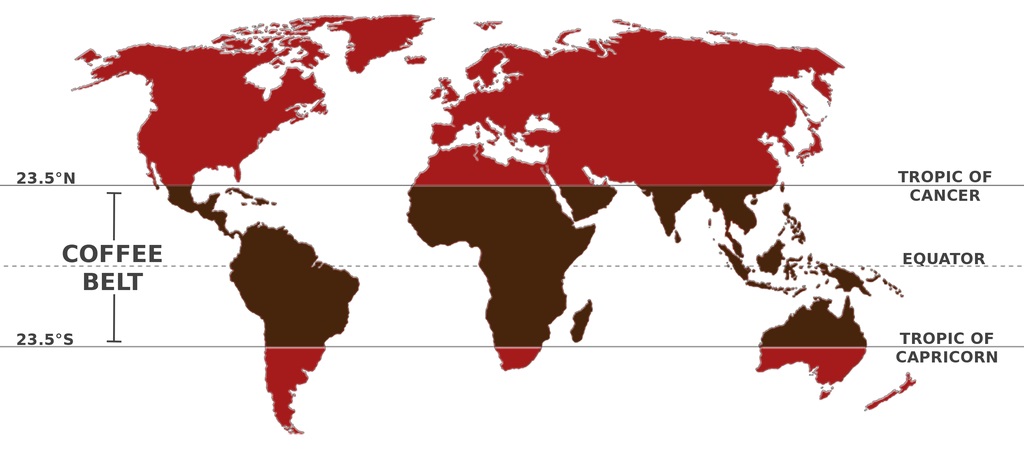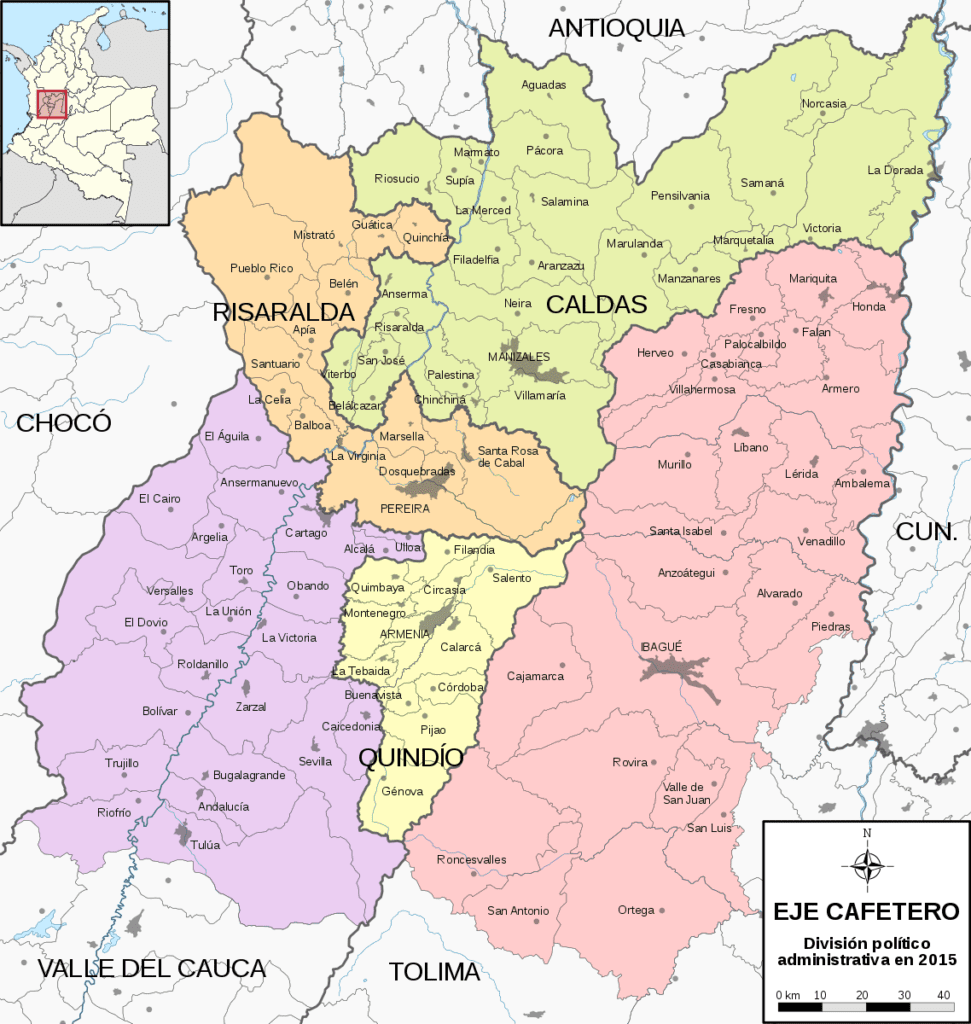Rolling mountain slopes filled with the red cherries of coffee fill the eye. A light fog comes in, and you hear the call of birds. What do you do on a typical morning? If drinking a cup of coffee comes to mind, you aren’t alone. Americans drink 88.8 gallons of coffee per year (1). But there are some concerns that the price of coffee can go up in the coming years. Climate change is a major effect within the coffee industry, directly impacting the regions where they are grown. The coffee farmers of Colombia, which is the world’s third largest producer of coffee (2) and the largest producer of mild washed Arabica coffee, have already been feeling the effects.
Rolling mountain slopes filled with the red cherries of coffee fill the eye. A light fog comes in, and you hear the call of birds. What do you do on a typical morning? If drinking a cup of coffee comes to mind, you aren’t alone. Americans drink 88.8 gallons of coffee per year (1). But there are some concerns that the habit may have to change. Climate change is a major effect within the coffee industry, directly impacting the regions where they are grown. The coffee farmers of Colombia, which are the world’s third largest producers of coffee (2) and the largest producers of mild washed Arabica coffee, have already been feeling the effects.
Coffee’s Climate Needs

Coffee is a particular crop. There is something called the “bean belt,” spanning the globe where the conditions to grow coffee are just right.(4) These places tick off the mildly warm daytime and cool night temperatures, and provide plenty of sunshine with just enough rainfall(5).

In Colombia, the Eje Cafetero or the Coffee Region (also known as Triángulo del Café or the Coffee Triangle) meets coffee’s growing criteria, made up of three main areas: Risaralda, Quindio, and Caldas(6). Only a total combined area of 13,873 square kilometers of small farms, cloud forest, and mountains, Triangle del Cafe is a designated UNESCO World Heritage site(7). In Colombia, the mountain range is the ideal home for coffee. But coffee agronomist Peter Baker, published an April 2019 study finding that the Colombian mountain range is warming at a rate of 0.3 degrees Celsius each decade and both extreme weather events and fungal diseases are becoming more common(3).
The higher the altitude, the more susceptible to changes in the climate. Rutgers climate scientist, Dr. Jim Miller found in a study published in the journal Naturalizations Climate Change that climate change occurs at “an accelerated pace in many high-altitude regions around the world” and that within the last 20 years, elevation above 4,000 meters warmed 75% faster than regions below 2,000 meters (8). It’s also less sunny. According to the study by Baker, the hours of sunlight declined by 19%, since the mid-20th century, due to more cloud cover. The study concludes “there is no longer enough sun to sustain high levels of coffee production in some areas.” (3)
Coffee farmer Gustavo Patino, who oversees a medium sized-coffee plantation of 44 acres, told Yale 360: “When we started the plantation, the neighbors said that we were crazy, it is too cold for coffee — now the altitude is just right for growing it…I have noticed big weather changes in the last 30 years. On the one hand, we have more extremely sunny days, and at other times there is too much rain.” (3)
A study from the independent Climate Institute has alarmingly reported that by 2050, the area suitable to grow coffee will be cut in half: “Increasing temperatures and extreme weather events will cut the area suitable for production by up to 50%, erode coffee quality, and increase coffee prices for consumers.” (9)
Coffee Farmers Experience with the Changing Climate
Small farmers bear the brunt of the problem. After signing a peace treaty in 2016 with the FARC (Fuerzas Armadas Revolucionarias de Colombia or the Revolutionary Armed Forces of Colombia) guerrillas, the largest rebel group in Colombia, the Colombian economy has become stronger, with the peso in good standing. However, this means the coffee exports are less competitive globally, contributing to labor shortages. Eise says of the farmers that “you can’t adapt to climate change when you are in poverty. And climate change exacerbates the stress of poverty. It’s a catch-22.” (3)

Adding on to this, VICE news found that Colombia’s National Federation of Coffee Growers or Fedecafé, a non-profit organization which coffee farmers are required to join and represents them both nationally and internationally, has played down and even denied climate change’s effect on coffee.
VICE cites Alvaro Jaramillo, Fedecafé’s main climatologist comment in 2012, stating “The climate on earth has been constantly changing for over 4.6 billion years and the formation of mountains and volcanic activity continues to create new weather cycles…Since 2007, what we have seen is that the world is actually entering a new era of global cooling.”(5)Colombia’s director for the Rainforest Alliance, Mauricio Galindo, has said that Fedecafé, which requires the farmers to pay a fee “equivalent to an income tax of 15.3 percent,” while helping farmers became stronger, has largely failed them when it comes to changes brought on by climate change.(5)
Looking to the Future
So what does the future of coffee look like for Colombia? In May 2019, Fedecafé reported that “Colombia has lost 40,000 hectares (99,000 acres) of coffee planting area over the last 18 months as farmers leave the industry amid low prices…The domestic price received by Colombian farmers for every 125 kg (275 lb) shipment was 688,000 pesos ($209), which does not cover production costs estimated at 780,000 pesos ($237). (11).
In addition, Fedecafé funds a research branch called Cenicafé. The group of 60 scientists are looking at genetic information of different coffee trees. They have developed a variety of coffee tree that is resistant to the deadly La Roya, or coffee leaf rust fungus. In 2012, the fungus caused over $3 billion of damage and loss to coffee crops throughout Latin America. The damage in Colombia was less severe then in other countries, because the leaf rust resistant varieties were already in parts of the country. In addition, production of coffee remains the same as two decades ago, despite roughly 20% less land to grow coffee, thanks to innovations by Cenicafé.(3)
But while this is hopeful news, the fact remains that the climate is changing. With it, that sweet spot where coffee grows will change, as will weather patterns. As Peter Baker bleakly but accurately says, “What all farmers want is reasonably stable conditions and they are not getting them and, frankly, it should be made clear to them that they will never return to the stable conditions of the past.”(5).
- https://www.marketwatch.com/story/international-coffee-day-americans-drink-more-coffee-than-soda-tea-and-juice-combined-2017-09-29
- https://www.coffeehunter.com/coffee-country/colombia/
- https://e360.yale.edu/features/as-climate-changes-colombias-small-coffee-farmers-pay-the-price
- https://climateimpactnews.com/solutions/environmental/10-climate/535-coffee-belt-feels-climate-squeeze
- https://www.vice.com/en/article/889d7g/colombias-national-coffee-organization-profits-off-climate-change-denial
- https://www.nomadcoffeeclub.com/pages/colombia
- https://whc.unesco.org/en/list/1121
- https://www.rutgers.edu/news/climate-change-affecting-high-altitude-regions-faster-rate-rutgers-study-finds
- https://climateimpactnews.com/solutions/environmental/10-climate/535-coffee-belt-feels-climate-squeeze
- https://innerself.com/content/social/environment/climate/impacts/17669-coffee-farmers-struggle-to-adapt-to-colombia-s-changing-climate.html
- https://www.reuters.com/article/us-colombia-coffee/colombia-losing-coffee-crop-area-due-to-low-prices-idUSKCN1SE2HK
- Mountains photo: Dan Gold
- Feature image: Rodrigo Flores
- Bean Belt map
- Map of Eje Cafetero by Milenioscuro








